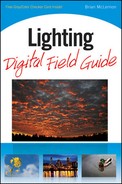Light. You can't make a photograph without it in some form or another. Although light has the ability to give your photographs power and definition, do you consistently consider the quality of light before pressing the shutter button? Sure, you're attracted to your subjects for who they are or to sunset and sunrise photos for the colors of the sky, but what about the quality of the light that defines these situations? Is there some other object or subject you could put into that light that would yield another great photo? That is the road you will be traveling with this book.
Welcome to the new Lighting Digital Field Guide. This book will put you on a new path of understanding and appreciation of the power of light in photography. Light comes in thousands of flavors and each one can be used to give your photographs more power when used correctly in the proper situations. By developing an awareness and sensitivity to light, you can begin to come up with picture-taking scenarios that make the best use of the light at hand or to take advantage of that light by quickly making camera exposure adjustments. This book is for those beginning photographers who are comfortable with their cameras but looking to take their photography further by searching out beautiful light.
Many years ago during an eight-hour photo workshop in New York City, the other attendees and I were challenged by the presenter to "see the light before taking the photo." By the sound of the audience's reaction, it appeared that many of us were confused, not really knowing what we were supposed to be looking for. As the many different qualities of light were explained and the numerous examples shown, it dawned on our group just how powerful a medium light can be and how important developing an understanding of it is. I realized that most of my previous thoughts about photography focused too much on camera and lighting gear (that which I did not own especially) and not really on light and its qualities. Almost overnight, I began to think of photography in a profoundly different way.
What began that evening and continued for many months afterward was a paradigm shift in my approach to photography. I began to really work hard to "see" light and all the subtle variations in natural light and also how to mimic those subtleties with studio flash equipment. Camera controls and settings were still very important, but now there was reasoning behind those decisions based on the quality of light I either had or wanted to create. All it took was noticing the quality of the light, where it was coming from, which way the shadows fell, and various other nuances. I contemplated lighting before considering what lens, ISO setting, aperture, or shutter speed to use.
Light from sun has the power to oxidize paint, blacken silverware, or burn your skin. Yet this same light can be used for beautiful purposes as well, such as creating dynamic three-dimensional effects in your photos. This book begins by describing the many qualities of natural light, what they are called, and where to find them. You learn how the direction and color of light affects your photos. Then you move on to determining which camera controls best complement the light's qualities. Full chapters are devoted to shutter speed and aperture, explaining how the light on your subject will often tell you which to choose first in order to get the effects you want.
After you learn about natural lighting and ways to get the quality of light you want from the sun outdoors, it's time to move into the studio to get acquainted with many of the types of equipment, tools, and light modifiers found there, and how and when to use them. The popularity of the small external flash units has risen enormously in the past several years, and this book extensively covers the exploding world of small flashes, referred to hereafter as speedlights. (Canon calls them Speedlites and Nikon calls them Speedlights, but in all my research I have found the speedlights label to be the most generic.)
As you begin to understand just how important and powerful light in your photography can be, look to later chapters that cover the most popular situations photographers find themselves in, namely shooting sports, concerts, landscapes, night scenes, portraits, products, weddings, wildlife, and pets. These chapters discuss specific considerations and practical pro advice for each genre.
It is my sincere hope that this book develops awareness in you that while good quality equipment is necessary, your understanding of light and of the varied methods used to manipulate and shape it, will help make your images much stronger. By "seeing the light" before taking the photo you begin to make conscious decisions when using the camera exposure settings to control and harness that power.
A long time ago, I came to a fork in the road of photography between purchasing more photo equipment or becoming a student of light. Knowing full well that good equipment is still important, I chose the light path. It is my honest desire that by studying this new Lighting Digital Field Guide, you will, too.
